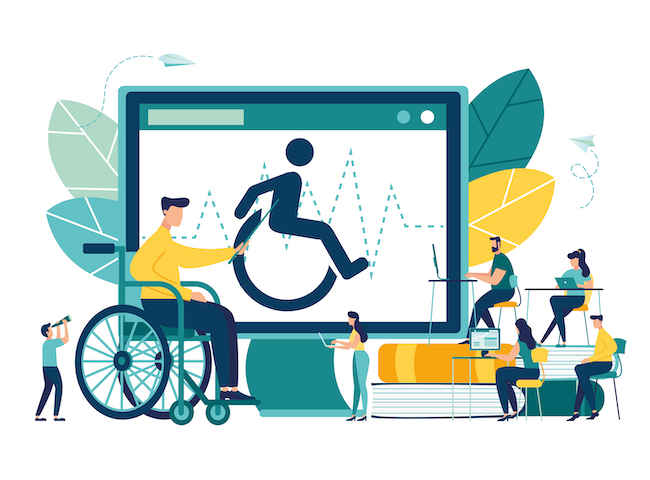

How Technology is Enhancing Accessibility
In recent years, technology has made tremendous strides in enhancing accessibility for individuals with disabilities. With the advancement of digital tools and innovative solutions, people with disabilities are now able to participate more fully in various aspects of life, from education and employment to social interactions and entertainment. This article will explore the ways in which technology is breaking down barriers and increasing accessibility, highlighting the benefits and opportunities that this brings.
Accessibility in Education
One area where technology has had a profound impact on accessibility is in education. Traditionally, students with disabilities have faced significant barriers in accessing educational resources and participating in classroom activities. However, with the help of technology, these barriers are being dismantled.
For instance, digital textbooks and e-learning platforms have made it possible for students with visual impairments to access educational materials in a format that is tailored to their needs. Text-to-speech software, screen readers, and braille displays have enabled students with visual impairments to engage with written content in a way that was previously impossible.
Furthermore, online learning platforms have opened up new opportunities for students with disabilities to access education remotely. This is particularly beneficial for students who may not have been able to attend traditional brick-and-mortar schools due to mobility issues or other constraints.
Accessibility in Employment
Technology has also revolutionized the workplace, making it more accessible for people with disabilities to participate in the workforce. With the rise of remote work, individuals with disabilities are no longer limited by geographical constraints or physical barriers.
For example, video conferencing tools have enabled individuals with mobility or hearing impairments to participate fully in virtual meetings and collaborate with colleagues remotely. Artificial intelligence-powered tools have also facilitated communication between individuals who speak different languages or have different abilities.
Moreover, virtual reality (VR) technology is being used to create inclusive and accessible work environments. For instance, VR training programs are being developed to simulate workplace scenarios, allowing individuals with disabilities to practice and develop skills in a safe and controlled environment.
Accessibility in Healthcare
Technology has also improved accessibility in healthcare, enabling individuals with disabilities to access medical services and information more easily. Telemedicine platforms have made it possible for individuals with mobility impairments to consult with healthcare professionals remotely, reducing the need for physical visits to hospitals or clinics.
Additionally, wearable devices and mobile apps have enabled individuals with disabilities to track their health and wellness more effectively. For example, fitness trackers can be adapted for individuals with mobility impairments, while mobile apps can provide personalized health advice and monitoring for individuals with chronic conditions.
Accessibility in Social Interactions
Technology has also facilitated greater social inclusion for individuals with disabilities. Social media platforms have created new opportunities for people with disabilities to connect with others who share similar experiences and interests.
For instance, online communities and forums have been established for people with specific disabilities, providing a safe and supportive space for individuals to share their experiences and connect with others. Video conferencing tools have also enabled individuals with disabilities to participate in virtual events and gatherings, reducing feelings of isolation and loneliness.
Accessibility in Entertainment
Finally, technology has also enhanced accessibility in entertainment, enabling individuals with disabilities to enjoy movies, music, and other forms of entertainment more easily.
For example, audio descriptions and closed captions have made movies and television shows more accessible to individuals who are deaf or hard of hearing. Digital music platforms have also made it possible for individuals with visual impairments to access music and audio content more easily.
Challenges and Opportunities
While technology has made significant progress in enhancing accessibility, there are still challenges to be addressed. One major concern is the digital divide, where individuals with disabilities may not have access to the technology or internet connectivity needed to fully participate in online activities.
Moreover, there is a need for greater awareness and understanding of accessibility issues among technology developers and designers. Many digital products and services are still not designed with accessibility in mind, creating barriers for individuals with disabilities.
However, these challenges also present opportunities for innovation and growth. As technology continues to evolve, there is a growing demand for accessible and inclusive digital products and services. This has led to the development of new industries and career paths focused on accessibility and inclusive design.
Conclusion
In conclusion, technology has had a profound impact on enhancing accessibility for individuals with disabilities. From education and employment to healthcare and social interactions, technology has broken down barriers and created new opportunities for inclusion and participation.
As technology continues to evolve, it is essential that we prioritize accessibility and inclusive design in the development of new products and services. By doing so, we can create a more equitable and accessible society, where individuals with disabilities are able to fully participate and contribute.
Ultimately, the future of accessibility is bright, and technology will continue to play a critical role in shaping a more inclusive and accessible world for all.




